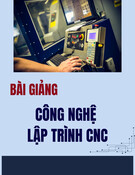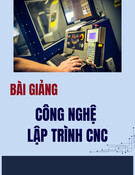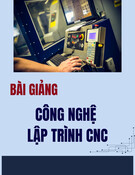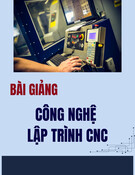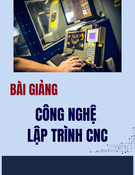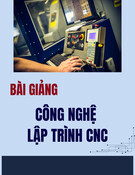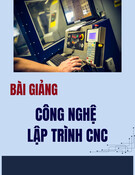
ISSN 1859-1531 - THE UNIVERSITY OF DANANG - JOURNAL OF SCIENCE AND TECHNOLOGY, VOL. 22, NO. 11B, 2024 91
MACHINE LEARNING APPLICATIONS FOR CHLORIDE INGRESS
PREDICTION IN CONCRETE: INSIGHTS FROM RECENT LITERATURE
Quynh-Chau Truong*, Anh-Thu Nguyen Vu
The University of Danang - University of Science and Technology, Viet Nam
*Corresponding author: tqchau@dut.udn.vn
(Received: September 07, 2024; Revised: September 22, 2024; Accepted: October 14, 2024)
DOI: 10.31130/ud-jst.2024.528E
Abstract - Chloride corrosion significantly impacts the durability
of reinforced concrete (RC) structures. Traditional evaluation
methods are time-consuming and expensive. Machine Learning
(ML) offers a promising alternative, providing efficient and
accurate predictions. This review explores recent ML
advancements in assessing corrosion in RC structures. Various
algorithms, such as Artificial Neural Networks (ANNs), Gene
Expression Programming (GEP), Extreme Gradient Boosting
(XGBoost), Support Vector Machine (SVM) and Ensemble
Learning, have shown potential in estimating corrosion processes,
predicting material properties, and evaluating structural
durability. Future research should focus on integrating ML with
physical models to enhance robustness and reliability in service
life prediction. This review summarizes current trends,
challenges, and the future potential of ML in predicting chloride
ingress and its impact on concrete durability.
Key words - short-term prediction; energy consumption; deep
learning; convolutional neural network; metaheuristic
optimization; time-series deep learning; machine learning
1. Introduction
The durability and lifespan of reinforced concrete (RC)
structures have been significant concerns for the
construction industry in recent decades. Corrosion-induced
deterioration of RC structures is a widespread and serious
global issue [1-3]. Especially, in a marine environment, RC
are exposed to have a higher risk of corrosion due to the
chloride penetration from seawater. Chloride-induced
corrosion can cause cracking, staining, loss of cross-
section, and delamination of the protective concrete layer
in RC structures. These not only affect the appearance,
stability, and safety of the structure but also create
economic liability for the stakeholders. It has been reported
that the maintenance and repair costs of RC structures due
to corrosion are in the billions of US dollars per year [4].
Structures with decreased durability are also unsustainable,
as maintaining their service life requires the repeated use
of valuable natural resources.
From another perspective, continuous corrosion of
reinforcing bars is also the most common failure mode in
repaired RC structures, accounting for 37% of the failure
modes [5-7]. Therefore, researchers are faced with the
pressing question of what method they can use to
accurately detect and predict early corrosion in RC
structures, especially those exposed to chloride-induced
corrosion in marine environments.
Conventional methods for assessing chloride ingress
primarily involve laboratory testing, such as accelerated
chloride migration or diffusion tests, and empirical models.
However, these methods present several limitations. For
instance, laboratory-based tests often require significant
time and resources, making them expensive and impractical
for large-scale or real-time applications. Furthermore,
empirical models such as Fick’s second law oversimplify the
complex chloride transport mechanisms by assuming a
constant diffusion coefficient, which does not adequately
account for varying environmental conditions and the
evolving properties of concrete over time [8].
The time-consuming nature of these tests is especially
problematic in marine environments, where chloride
ingress can vary significantly due to factors like
temperature fluctuations and humidity. As a result,
traditional approaches struggle to capture these dynamic
interactions, leading to less accurate predictions of chloride
ingress and its impact on the durability of concrete
structures. This inadequacy calls for more efficient,
flexible, and accurate alternatives.
Machine learning (ML) techniques address many of
these drawbacks by offering a data-driven approach to
predicting chloride ingress. Unlike traditional methods, ML
models can analyze vast datasets and account for complex,
non-linear interactions between variables, leading to more
accurate and faster predictions. For example, ML algorithms
like artificial neural networks (ANNs), support vector
machines (SVMs), and ensemble learning methods are
capable of processing multiple factors simultaneously, such
as material composition, environmental conditions, and
exposure time, providing a more comprehensive
understanding of chloride diffusion in RC structures. These
models significantly reduce the time and cost associated
with chloride ingress prediction, while also enhancing the
precision of service life assessments.
Given these advantages, the need to transition from
traditional methods to ML-driven approaches is becoming
increasingly clear. The integration of ML into chloride
ingress prediction not only improves the accuracy and
efficiency of corrosion evaluations but also paves the way
for more sustainable and resilient concrete structure
designs [9].
Although ML has been widely applied to evaluate the
corrosion level of RC structures, there are still several gaps
that remain unaddressed. For example, addressing current
challenges in corrosion, managing the source and quality
of the data needed for ML method, and selecting the most
appropriate and advanced algorithms are critical.
Enhancing these factors will significantly boost the

92 Quynh-Chau Truong, Anh-Thu Nguyen Vu
efficiency of ML models in the future, amplifying their
benefits in terms of time and cost savings. More crucially,
accurate predictions of corrosion throughout a structure's
lifespan can fundamentally improve the corrosion
resistance of materials and structures, thereby extending
their durability and sustainability. This, in turn, can lower
construction and maintenance costs, contributing to
environmental protection and energy conservation.
This review paper has three main objectives: (i) to
provide an overview of machine learning in the context of
chloride ingress; (ii) to examine the current applications of
machine learning in predicting chloride ingress in concrete
in recent years; and (iii) to offer insights into future
directions that could enhance ML applications in corrosion
assessment. It is noted that the references used in this study
come from renowned scientific databases and mostly focus
on the most recent five-year period from 2019 to 2024.
2. Overview of machine learning in the context of
chloride ingress
Chloride ingress into concrete greatly impacts the
durability and structural integrity of concrete structures,
particularly in marine environments. The entry of free
chloride ions can compromise the passivation of the steel,
leading to rebar corrosion. This can also result in the
formation of expansion cracks in the concrete [10].
Chloride ions can move quickly through these cracks,
further speeding up the corrosion process. Factors such as
the concentration of chloride ions and their rate of
penetration influence the corrosion conditions of
reinforcement in RC structures, especially when the
chloride content on the reinforcement surface exceeds a
specific threshold value [11].
For chloride ingress in concrete, diffusion is the
primary mechanism where chloride ions move from areas
of higher concentration to lower concentration through the
pore structure [1,2]. The diffusion process is expressed
based on Fick's second law, as shown in Eq. (1). Many
models based on Eq. (1) have been developed to estimate
chloride penetration and assess the overall or remaining
service life of RC structures. However, these models have
various limitations that introduce uncertainty in predicting
chloride ingress accurately. For instance, Eq. (1) does not
consider the effects of factors such as loading, temperature,
and chemical reactions, which can significantly influence
the rate and behavior of diffusion in real-world situations.
Another limitation is the assumption that the non-steady
diffusion coefficient (𝐷𝑐) remains constant [16-19]. In
reality, (𝐷𝑐) should not be treated as a constant, as the
transport properties of chloride depend on the intrinsic
permeability of the concrete, which evolves over time
during the cement hydration process.
𝐶𝑥,𝑡 = 𝐶0+𝐶𝑠(1−𝑒𝑟𝑓(𝑥)[𝑥
2√𝐷𝑐(𝑡)]) (1)
where, 𝐶𝑥,𝑡 (kg/m3) is the content of chloride ion measured
at average depth 𝑥 [m] after exposure time 𝑡[s]; 𝐶𝑠 is the
calculated content of ions at the exposed surface (kg/m3);
𝐶0 is the initial content of chloride ion; 𝐷𝑐(t) is the non-
steady state diffusion coefficient of chloride ion [m2/s.];
and 𝑒𝑟𝑓(𝑥) is the error function [−].
Given the limitations of existing models, traditional
simulation approaches necessitate the integration of multiple
factors, complicating the process. In contrast, ML offers a
significant advancement over traditional empirical models
for predicting chloride ingress in concrete. ML is widely used
to improve or replace traditional methods in the design,
construction, maintenance, and management of RC
structures. While data is the foundation of ML, the essence
lies in the algorithmic models that enable machines to process
and learn from different types of data. Common applications
include response surface recognition, natural language
processing, and autonomous driving. ML can be categorized
into four types based on the learning requirements:
reinforcement learning, semi-supervised learning,
unsupervised learning and supervised learning (Figure 1).
Figure 1. Classification of machine learning algorithms
In the domain of durability evaluation of RC structures.
Caused by environmental corrosion, supervised learning
algorithm is the most common one. In supervised learning,
a function is derived from a given data set, which can then
be used to make predictions as new data is added. This
approach relies on both input and output data, referred to
as features and targets respectively, with the targets being
pre-labeled by the engineers. By training models with
historical data, ML algorithms can predict the penetration
of chloride into concrete with great accuracy and speed.
Artificial Neural Networks (ANNs), Decision Trees (DTs),
Gene Expression Programming (GEP), Support Vector
Machine (SVM), and Ensemble learning have emerged as
commonly used models due to their ability to handle non-
linear relationships between input parameters and chloride
diffusion. Besides, surrogate modeling is an application of
supervised machine learning that could be implemented in
this context.
The application of ML to identify key parameters
related to the penetration of chloride into concrete, such as
the chloride diffusion coefficient, 𝐷𝑐(t), the chloride
concentration in the concrete, 𝐶𝑥,𝑡, and the chloride
concentration at the surface, 𝐶𝑠, represents a significant
advance in the field of materials science and construction
(as shown in Figure 2). ML algorithms can analyze
extensive data sets derived from experimental studies and
field measurements. This enables the identification of
complex, non-linear relationships between different factors
that influence chlorine transport. By training ML models
on these datasets, researchers can more accurately predict
the chloride diffusion coefficient, taking into account
variables such as temperature, moisture, and concrete
composition that traditional models may overlook.

ISSN 1859-1531 - THE UNIVERSITY OF DANANG - JOURNAL OF SCIENCE AND TECHNOLOGY, VOL. 22, NO. 11B, 2024 93
In addition, ML techniques can be used to estimate
chloride concentrations at different depths and times,
facilitating real-time monitoring of concrete structures.
This predictive capability not only improves the
understanding of the dynamics of chloride intrusion but
also enables proactive maintenance strategies that
ultimately extend the life of RC structures.
Figure 2. Machine learning application in chloride penetration
in concrete
Moreover, ML models can refine the prediction of
chloride concentration at the surface by incorporating
factors such as environmental conditions and the effects of
protective coatings. This comprehensive approach
increases the reliability of corrosion assessments and helps
engineers make informed decisions about material
selection and design strategies to effectively mitigate
corrosion risks. Overall, the integration of ML in this
context represents a transformative shift towards more
sophisticated, data-driven methods in analyzing the
durability of concrete.
Therefore, the focus of this review is on studies dealing
with the application of ML to predict the key parameters
mentioned above, which are discussed in more detail in the
following section.
3. Proposed DP-FBI-FCM algorithm
3.1. Prediction of chlodride diffusion coefficients, 𝑫𝒄
The chloride diffusion coefficient is an important index
when assessing the durability of concrete structures using
the performance-based method. However, the prediction of
this index is difficult due to the influence of many factors,
such as mix design, substitution of supplementary
cementitious materials, and choice of binder. Reccently,
Tran [12] used eight ML models including Support Vector
Machine (SVM), Extreme Learning Machine (ELM), K-
Nearest Neighbors (KNN), Light Gradient Boosting
(LGB), Extreme Gradient Boosting (XGB), Random
Forest (RF), Gradient Boosting (GB) and AdaBoost (AdB)
to predict the chloride diffusion coefficient of concrete
containing additional materials such as silica fume, finely
ground blast furnace slag, and fly ash. The database is
created with nine input variables and 386 samples. The
results show that Gradient Boosting (GB) has the highest
predictive performance while helping to identify important
input variables, thereby supporting the optimization of mix
design and binder selection for concrete, which improves
structural durability.
In parallel, Taffese and Leal [13] expanded the research
by working with a larger dataset of 1037 samples, divided
into subsets ranging from 91 to 176 samples. The authors
applied XGBoost to predict the chloride diffusion
coefficient, emphasizing the importance of both fresh and
hardened concrete properties. Like Tran [12], Taffese and
Leal highlighted the adaptability of XGBoost (Extreme
Gradient Boosting) for different dataset sizes and
complexities, reinforcing the model’s effectiveness.
Meanwhile, Golafshani et al. [14] extends the
application of ANNs by integrating metaheuristic
algorithms like the Whale Optimization Algorithm and
Jellyfish Search Optimizer to predict the apparent chloride
diffusion coefficient. This study emphasizes the
importance of curing time and concrete composition in
marine environments, analyzing data from 216 records
across multiple studies. The novel use of metaheuristics
combined with ANNs allows for greater accuracy in
predicting concrete performance under varied exposure
conditions.
Hosseinzadeh et al. [15] synthesized these findings
through a comprehensive review of ML applications in
chloride diffusion studies. Though no new dataset was
introduced, the review shed light on various studies,
including Cai et al. [16], Ahmad et al. [17], and Tran [12],
focusing on input parameters and the versatility of models
like artificial neural networks (ANN) in handling missing
data. This work provided an overarching analysis of how
different ML approaches have been applied in this domain.
Liu et al. [8] further investigated the chloride diffusion
coefficient in concrete, using input variables such as coarse
aggregate content, curing time, and water/cement ratio.
Although the sample size was not specified, Liu employed
ML models like back-propagation artificial neural
networks (BP-ANN), support vector regression (SVR), and
XGBoost. Interestingly, Liu found that XGBoost
outperformed other models, a result consistent with
Taffese and Leal [13].
Zhang et al. [18] added to this body of research by
analyzing chloride diffusion in concrete using a dataset of
843 samples. Zang tested models such as SVM, ANN, and
KNN, with SVM producing the most accurate predictions
for diffusion. This reinforced the findings of Ahmad et al.
[17] and Liu et al. [8], confirming the reliability of SVM
for complex prediction tasks. Zang’s use of a large and
diverse dataset highlighted the benefits of larger sample
sizes in improving model accuracy.
Finally, Zheng and Cai [19] explored the chloride ion
diffusion coefficient in concrete, focusing on the use of
artificial sand. With a smaller dataset of 82 samples, Zheng
examined four key input variables, including water-to-
binder ratio and fly ash content, contributing to a niche area
within chloride migration studies.
Taken together, these studies show that ML models,
particularly ANNs, XGBoost and SVM, are becoming
more sophisticated in handling different data sets and
complex input variables for the accurate prediction of
chloride diffusion in concrete.

94 Quynh-Chau Truong, Anh-Thu Nguyen Vu
3.2. Prediction of chlodride concentrations in concrete, 𝑪𝒙,𝒕
In the field of chloride concentration prediction in
concrete, studies such as those by Taffese and Sistonen
[20], Delgado et al. [21], Liu et al. [22] have significantly
contributed by examining various aspects of concrete
composition, curing conditions, and environmental
exposures. These works utilize artificial neural networks
(ANNs) and other ML algorithms to model chloride-
related metrics, advancing the understanding of how
different factors influence chloride ingress and resistance
in concrete structures.
Taffese and Sistonen [20] made an early contribution to
the prediction of chloride ingress in concrete by utilizing
bagged regression trees to identify the most critical factors
affecting chloride penetration. By focusing on key
variables such as the water/cement ratio and exposure time,
Taffese and Sistonen ' model enhanced prediction accuracy
by streamlining the analysis to only essential factors,
offering a more efficient approach to chloride resistance
evaluation.
Delgado et al. [21] further advanced this field by
applying artificial neural networks (ANNs) to predict both
the depth of chloride penetration and the chloride diffusion
coefficient. This study emphasized the importance of input
variables such as cement type, water/cement ratio, and
curing conditions, demonstrating the strength of ANNs in
modeling the complex interactions governing chloride
ingress into concrete.
Liu et al. [22] expanded the focus by employing
ensemble ML models to predict chloride resistance in
recycled aggregate concrete using a dataset of 226 samples.
Although the ensemble methods proved effective, Liu
highlighted limitations in dataset size, indicating potential
challenges in applying these findings to other concrete types.
Collectively, these studies highlight the progressive
application of ML models, especially ANNs and ensemble
methods, in predicting chloride concentrations. By refining
key variables related to material composition, curing
conditions, and environmental factors, each study builds on
the previous ones to improve prediction performance and
reliability in various concrete types.
3.3. Prediction of surface chloride concentrations, 𝑪𝒔
The prediction of chloride surface concentration is
crucial for assessing the durability of marine concrete
structures.
Cai et al. [16] focuses on predicting the surface chloride
concentration in marine concrete using an ensemble ML
model. This model integrates predictions from multiple
individual models to improve accuracy. The study employs
a substantial dataset of 642 records collected from real-
world structures exposed to marine environments,
specifically in three zones: submerged, tidal, and splash.
The model incorporates 12 input variables, including
concrete composition (cement, fly ash, blast furnace slag,
silica fume, superplasticizer, water, fine aggregate, and
coarse aggregate), environmental conditions (annual
average temperature and chloride concentration in
seawater), exposure time, and type of exposure. The output
generated by the model is the surface chloride
concentration expressed as a percentage of concrete mass.
Cai's research compares the ensemble ML model
against five individual models-Linear Regression,
Gaussian Process Regression, Support Vector Machine,
Multi-Layer Perceptron Artificial Neural Network (MLP-
ANN), and Random Forest-alongside eight traditional
quantitative models. Results indicate that the ensemble
model significantly outperforms its counterparts in
predicting surface chloride. One notable advantage of the
ML approach is its capacity to consider multiple variables
simultaneously, unlike traditional models, which often
focus on a limited number of factors. The study identifies
environmental conditions and the water-to-cement ratio as
the most influential factors affecting 𝐶𝑠. Notably, concrete
in tidal zones exhibits the highest chloride concentration on
the concrete surface, followed by splash zones, while
submerged zones show the lowest levels. Furthermore, an
increased water-to-cement ratio correlates with higher 𝐶𝑠.
Ahmad et al. [17] also investigates surface chloride
concentration in concrete, utilizing 12 input variables
similar to those in Cai's study. Ahmad employs multiple
ML models, including Gene Expression Programming
(GEP), decision trees, and artificial neural networks
(ANN). The findings reveal that GEP delivers the most
accurate predictions, although the specific number of data
samples used remains unspecified. This work emphasizes
the critical role of ML in predicting chloride behavior and
enhancing concrete durability, aligning with the broader
focus of research in this field. Together, these studies
underscore the growing importance of advanced predictive
models in assessing the durability of concrete structures
exposed to chloride-rich environments.
4. Challenges and future directions in ML application
Building on previous analyses of chloride diffusion and
concentration predictions, it is evident that ML plays a
crucial role in assessing corrosion in concrete structures.
Despite advancements in ML applications, challenges
persist, such as the complex interactions among various
factors and the time-dependent nature of corrosion. This
section will explore recent developments in ML algorithms
and their future directions in corrosion assessment,
emphasizing the need to address these challenges to
enhance the durability of RC structures.
4.1. Prediction model considering for the coupling of
multiple factors
The degradation of RC structures is a result of the
complex interaction between various environmental,
chemical, and physical factors. Understanding how these
factors couple and influence one another is essential for
accurately predicting the durability and long-term
performance of RC structures
Zhu et al. [23] have shown that the interaction
between chloride ingress and carbonation can
significantly influence the corrosion of reinforcement.
While carbonation compacts the concrete and can reduce

ISSN 1859-1531 - THE UNIVERSITY OF DANANG - JOURNAL OF SCIENCE AND TECHNOLOGY, VOL. 22, NO. 11B, 2024 95
chloride diffusion by up to 50%, it initially reduces the
chloride concentration at the surface. However, as
carbonation progresses, the chloride ion concentration
can eventually increase and lead to cracking. The pH
values after carbonation also influence the chloride
content. Conversely, chloride-induced corrosion can
reduce porosity and thus slow down carbonation, while
chloride-induced cracking can further accelerate the
carbonation process.
Moreover, the interactions between steel and concrete
play a critical role in their deterioration over time.
Corrosion leads to rust accumulation, which weakens the
bond between these materials and compromises structural
strength. Several factors influence this process, including
the chloride ion concentration, the condition of the
reinforcement surface, the availability of oxygen and the
nature of the corrosion products. Although understanding
the dynamic corrosion rate is fundamental, traditional
models often oversimplify or ignore these factors, leading
to inaccuracies in predicting long-term corrosion behavior
and assessing the durability of RC structures [24].
ML, however, can simultaneously account for most
influencing factors, providing new insights into corrosion
dynamics. ML algorithms can incorporate time and spatial
variations of corrosion [25], making them more suitable for
predicting long-term corrosion changes. Given the gaps in
current research on chemical and physical degradation, the
long-term durability of RC structures remains uncertain.
Complex reactions in RC make it difficult to maintain
consistent corrosion rates across different components
[26]. Additionally, traditional methods fall short of
addressing these issues comprehensively, especially under
combined corrosion and sustained loads.
4.2. Incorporating environmental variability
Chloride ingress and corrosion in RC are significantly
affected by environmental factors such as temperature
fluctuations, humidity levels, rainfall, wind speed, and
exposure to chemical agents like chlorides and sulfates.
These factors can vary greatly over time and across
different geographic locations, introducing substantial
complexity to the modeling of chloride ingress. Traditional
ML models often struggle to fully capture these dynamic
and interdependent environmental conditions, which can
lead to less reliable or inaccurate predictions.
To enhance the accuracy of ML models, it is crucial to
incorporate time-series data that reflects the changes in
environmental conditions over time. This involves
collecting detailed, continuous data on local climate
conditions, seasonal variations, and specific exposure
scenarios that affect the concrete's microstructure and
chloride diffusion rates. For example, capturing data on
diurnal temperature variations and their impact on moisture
transport within the concrete can significantly improve the
model's ability to predict corrosion progression. By
utilizing this temporal data, ML models can better
understand the patterns and trends that drive chloride
ingress, leading to more realistic predictions under
fluctuating environmental conditions.
Furthermore, integrating ML with physical and
chemical corrosion models can bridge the gap between
data-driven predictions and fundamental corrosion
mechanisms. Hybrid models that combine the strengths of
ML and traditional mechanistic models can leverage the
predictive power of ML algorithms while still respecting
the underlying principles of chloride diffusion, hydration,
and concrete deterioration. For instance, ML models can
be trained on data derived from mechanistic simulations
that account for factors like pore structure, chloride binding
capacity, and water-cement ratios, providing a
comprehensive understanding of how these factors interact
under different environmental conditions.
Advanced approaches such as multi-task learning and
transfer learning can also play a critical role. Multi-task
learning allows the ML model to learn from multiple
related tasks simultaneously, thereby understanding the
combined effects of various environmental conditions on
chloride ingress. Meanwhile, transfer learning can help
adapt models developed for specific climates or conditions
to new environments with limited data, enhancing their
applicability across diverse geographical regions.
Moreover, the integration of Internet of Things (IoT)
sensors and remote monitoring technologies can provide
real-time data on environmental conditions, which can be
fed into ML models to continuously update and refine
predictions. By leveraging such technologies, it is possible
to create adaptive, responsive models that dynamically
adjust their predictions based on current conditions,
providing more accurate and timely assessments of
chloride ingress risk.
4.3. Databases
Currently, various materials databases have been
developed through simulations and experimental studies.
However, many entries do not meet specific requirements
due to the lack of standardized data collection methods
across different countries, regions, and applications. This
inconsistency leads to diverse data that can hinder reliable
modeling. As Zhai et al. [27] noted, several modeling
techniques have been explored, including atomistic
modeling, coarse-grained modeling, and macroscale
modeling, with ML algorithms showing effectiveness
across these scales. Multiscale data, influenced by
microstructures, significantly impact the behavior of RC.
For example, Wang et al. utilized ML techniques to refine
elastic constants from density functional theory
calculations.
To maximize the effectiveness of ML models, large,
diverse datasets covering various environmental
conditions, material properties, and exposure times are
essential. Unfortunately, existing datasets often have
narrow scopes, limiting their generalizability.
Additionally, inconsistencies in data collection-such as
varying chloride exposure tests and concrete mix designs-
can introduce biases that undermine ML predictions.
Addressing these challenges requires standardized
testing protocols to ensure consistency across datasets.
Developing universal guidelines for data collection,







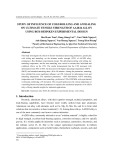
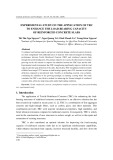
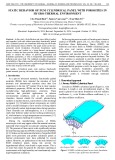
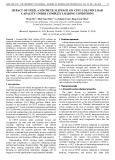
![Bài tập tối ưu trong gia công cắt gọt [kèm lời giải chi tiết]](https://cdn.tailieu.vn/images/document/thumbnail/2025/20251129/dinhd8055/135x160/26351764558606.jpg)




